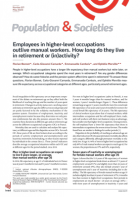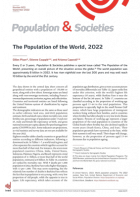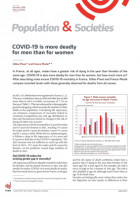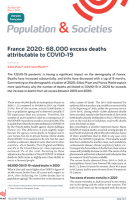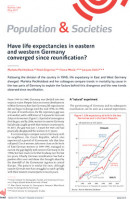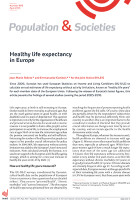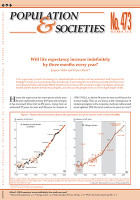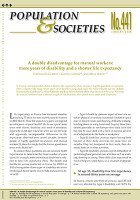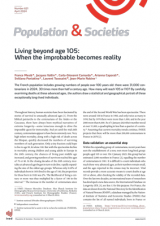
Living beyond age 105: When the improbable becomes reality
Population and Societies
n° 621, April 2024
https://doi.org/10.3917/popsoc.621.0001
Institut national d’études démographiques (INED)
Institut national d’études démographiques (INED)
Institut national d’études démographiques (INED)
Institut national d’études démographiques (INED)
Institut national d’études démographiques (INED)
Independent consultant
Institut national de la santé et de la recherche médicale (INSERM), EPHE
Deaths at very advanced ages have increased considerably in the last two decades. The exact number of such deaths documented in the International Database on Longevity IDL is established only after a strict age validation process. The vast majority of people who attain these exceptional ages are women. Supercentenarians (aged 110 or above) are over-represented in Guadeloupe and Martinique.
mortality, centenarians, supercentenarians, deaths, advanced ages, longevity, France, data
Table of contents
- Appendix A References
1.
The French population includes growing numbers of people over 100 years old: there were 31,000 centenarians in 2024, 30 times more than half a century ago. How many will reach 105 or 110? By carefully examining deaths at these advanced ages, the authors draw a statistical and geographical portrait of these exceptionally long-lived individuals.
Throughout history, human societies have been fascinated by stories of survival to unusually advanced ages [1]. From the biblical patriarchs to the centenarians of the Andes or the Caucasus, there have always been mythical narratives of extreme longevity—some tenacious enough to drive the impossible quest for immortality. And yet until the mid-20th century, centenarians appear to have been extremely rare. Very high infant mortality, along with a high risk of death across the lifespan, quickly decreased the numbers of surviving members of each generation. Only a tiny fraction could hope to live to age 90, let alone 100. But with the spectacular decline in mortality among children and young adults in Europe in the 20th century, the chances of living past middle age increased, and growing numbers of survivors reached the ages of 70 or 80. In the closing decades of the 20th century, mortality at advanced ages began in turn to decline, rapidly expanding the size of the oldest age groups. Whereas only 0.02% of individuals born in 1850 lived to the age of 100, the proportion for those born in 1920 was 2%. The likelihood of living a century or more was thus multiplied by a factor of 100 in the interval.1 The increase in the number of centenarians since the end of the Second World War has been spectacular. There were around 100 in France in 1900, and only twice as many in 1950, but by 1970 there were more than 1,000, and in the year 2000 more than 8,000. As of 1 January 2024 their number stood at over 31,000, a quadrupling in less than a quarter of a century.2 Assuming that current mortality trends continue, INSEE projects that there will be more than 200,000 centenarians in France in 2070 [2].
1.1. Data validation: an essential step
Within the expanding group of centenarians, recent years have seen the establishment of a new, even more long-lived group: people aged 105 or over. On 1 January 2023, this group had an estimated 2,000 members in France [2], equalling the number of centenarians in 1981. It is difficult to count individuals who reach these very advanced ages, as their numbers remain small, and the reported ages in the census may be incorrect. Vital records provide a more accurate means to count deaths at age 105 or above, after checking the validity of the recorded data. Over the last two decades, an international team of researchers has developed a new data source, the International Database on Longevity (IDL [3], see Box 1) for this purpose. For France, the data are drawn from the National Directory for the Identification of Natural Persons (RNIPP), a database managed by the National Institute of Statistics and Economic Studies (INSEE) that contains the list of all named individuals, born in France or abroad, who possess a social security number [4]. When one of these individuals dies in France, or their death abroad is reported to the French authorities, the death is registered in the RNIPP. For the French data in the IDL, INSEE provides INED with an annual list of persons born in France (metropolitan France and overseas departments) who died at age 105 or above in the preceding two years. These data are then systematically verified in full for all individuals who reached age 110 or over, and in part for those who died at ages 105-109. This involves checking the accuracy of the characteristics reported in the RNIPP (dates and places of both birth and death) by matching them against against individual vital records (birth and death certificates) of each person. While errors are relatively rare among deaths below age 110 (0.7%), a much larger share of cases at this age or above are excluded after verification (around 8% [5]).
1.2. Growing numbers of deaths beyond age 105
RNIPP data show trends over time in the annual number of deaths at ages 105 or above (Figure 1). While representing a minute fraction of the over 600,000 deaths recorded annually in France (under 0.15%) their number has surged in recent years, rising from just a handful of individuals in the late 1980s to 924 in 2020. The dip observed in 2021 and 2022 does not reflect a drop in the probability of reaching age 105, but rather the arrival at this age of the smaller cohorts born during the First World War. The collapse in births (by more than 40%) between 1915 and 1919 continues to have repercussions 105 years later. The fact that the decline is not already apparent in statistics from 2020 is likely due to the increase in deaths during the COVID-19 epidemic.
The vast majority of people who die at age 105 or above are women (843 women and 81 men in 2020, or 10 times more women). This impressive ratio is entirely due to excess male mortality, which operates throughout the lifespan, particularly at working ages, decreasing the share of males as the generation gets older. Births have an opposite effect, as slightly more boys than girls are born each year. Immigration, which could modify the sex ratio, has no effect here, as only individuals born in France are included in the IDL for France.
The predominance of women in the pyramid of deaths at age 105 or above is even more impressive. Figure 2 clearly shows the male-female contrast in numbers of deaths, along with the concentration of male deaths at the ‘youngest’ ages, with the male bars dwindling almost to invisibility beyond age 108.
1.3. Beyond age 110: Supercentenarians
People who reach the age of 110 are known as ‘supercentenarians’. While still a rare event, it has become much more frequent in recent decades (Fig. 3). No deaths in this age range are recorded in the RNIPP before 1987, and it would be another two decades before the number reached double digits. It has since grown considerably, while fluctuating widely due to the small annual numbers concerned. In 2022, 39 deaths at age 110 or above were recorded. Predictably, the overwhelming majority were women: 38 out of the 39. This predominance has remained constant over time, as can be seen in Figure 3, where the curve for all deaths at age 110 or above is almost identical to the curve for women’s deaths at those ages. At the department level in metropolitan France, the ratio of deceased supercentenarians to the total population ranges from 0 to 17 per million inhabitants, but with no clear geographical pattern. Guadeloupe and Martinique, with 44 and 36 supercentenarians per million inhabitants, respectively, stand out clearly from the rest of France, however (see Box 2).
Both the increase in the number of supercentenarians in recent years and the predominance of women at these ages have been observed in all countries where it is possible to validate age at death (see Box 1). The number itself depends, of course, on the size of the population, and more exactly on the size of the cohorts born 110 years earlier. France outperforms England and Wales, for example, for which comparable data are available. In 2020, the latest year available for England and Wales, the ratio of individuals who died at age 110 or above (11) to the size of the 1906–1910 birth cohorts was 2.4 per million, versus 6.9 per million in France. This French supercentenarian advantage, which remains to be confirmed in comparisons with more countries, is consistent with Natalie Blanpain’s finding that the probability of becoming a centenarian is higher in France than in 15 other European countries [2].
More anecdotally, two of the four individuals worldwide recognized as having lived more than 118 years are French women (along with one woman in the US and one Japanese woman): Jeanne Calment, the oldest recorded human being at age 122 years and 5 months, and more recently Lucile Randon, who died in 2023 just before her 119th birthday (118 years and 11 months).
1.4. Does the risk of death level off at very advanced ages?
In addition to counting verified cases and validating the extreme ages attained by a small number of individuals, demographers study deaths at age 105 and above in order to refine their estimates of the risk of death at very advanced ages. While it is now possible to accurately trace the mortality curve up to age 100 (for cohorts born in 1901–1905, a woman aged 100 had a one-in-three chance of dying before her next birthday), risks of death beyond that age are still fluctuating and uncertain (Figure 4), particularly for men. At these advanced ages, the numbers of observations remain insufficient to settle an ongoing debate among researchers. Some argue that mortality continues to increase exponentially with age, as seen at younger ages, while others hold that this increase slows, or even levels off to reach a mortality plateau [6]. In coming years, as the quantity of reliable data in the IDL increases, it should become possible to determine the shape of the mortality curve at very advanced ages with less uncertainty.
1.4.1. Box 1. The International Database on Longevity
The data used in this article are taken from the International Database on Longevity (IDL) (www.supercentenarians.org). The IDL contains verified demographic data on individuals who have lived 105 years or more, which can be used to measure mortality at very advanced ages.
The IDL is open access, and provides anonymous data on each individual’s sex, date and place of birth and death. It currently includes information on 22,135 individuals who died in 13 countries. It is regularly updated, and will be progressively expanded with data from additional countries once the quality of their data has been verified.
To ensure that the data are exhaustive and unbiased, the IDL relies on sources (such as civil registers) that systematically cover all deaths in a given period, among the entire population of a given area. While the deaths of exceptionally elderly people are often reported in the press and other media, these sources are unreliable because the likelihood of reporting increases with age, thus creating upward bias in the age structure of these deaths.
Furthermore, the reported age at death may itself be overestimated because of the particular value placed on reaching a great age. These mortality data collected from exhaustive sources must therefore undergo a strict age validation procedure to check that the date of birth and identifying information on the death certificate are consistent with those on the birth certificate.
Where vital records from the late nineteenth century are incomplete, other sources providing reliable information on the person’s date of birth must be used. In the United States, for example, where vital records were not yet exhaustive at that time, the procedure relies on the use of nominal census lists to confirm the age of young children when they were first counted in the census.
This validation process is applied to all IDL data, either exhaustively or on samples.
1.4.1. Box 2. Unexpected frequency of supercentenarians in Guadeloupe and Martinique
Out of the 373 deaths of supercentenarians recorded in France (excluding Mayotte) between 1978 and 2022 in the RNIPP, 32 occurred in the overseas departments, the vast majority (29) in Guadeloupe and Martinique. Adjusted for population size, the frequency of these cases on the two Caribbean islands is 39 per million, versus only 5 per million in metropolitan France. Proportionally, then, there are nearly eight times more supercentenarians in Guadeloupe and Martinique than in metropolitan France. This ratio is clearly to the advantage of these overseas departments, starting at ages 105–109 years (2.9). This difference is all more the surprising given that life expectancies at birth in Guadeloupe and Martinique are substantially lower than in metropolitan France (in 2022, 83.5 years for women in Guadeloupe and 82.8 years in Martinique, versus 85.2 ears in metropolitan France).
What might explain this advantage? As detailed above, supercentenarians are only included in the IDL database after a strict validation process, with matching of the birth and death records of each potential supercentenarian to ensure that the data are accurate. Could this process be insufficient for the overseas departments, where the vital registration system in the late 19th and early 20th centuries was perhaps not as reliable as in metropolitan France? A detailed analysis of the reproductive history of the mothers of Guadeloupean supercentenarians has established that there were no substitutions of identity between a child and a previous child who died before being declared, ruling out almost the only possible cause of error in the recorded age of a person whose birth and death certificates are available [7].
Is it an environmental effect (climate, colonial history, lifestyle, etc.)? If this were the case, why would the same advantage not be found on another French island such as La Réunion? An alternative hypothesis could be linked to way these islands were settled. Their populations are mainly the descendants of enslaved people displaced in the Atlantic slave trade, who were taken across the ocean by ship under horrifying conditions to which the enslaved people of La Réunion were not exposed. The multiple deaths during and after these crossings may have led to a selection of the most robust individuals, and thus potentially of genes linked to longevity. Indeed, genealogical research already carried out on around half of the supercentenarians from Guadeloupe and Martinique has shown that they are all the descendants of enslaved people. Mere randomness in the initial settlement of the islands and the evolution of the population in an insular environment may also be a factor behind this longevity, a phenomenon also observed on other islands, such as Sardinia in Italy, Ikaria in Greece, and Okinawa in Japan. Genetic studies are the only way to confirm such hypotheses.
Appendix A References
-
[1] Camarda C. G., Robine J.-M. Forthcoming. Limit of human longevity: Historical perspectives and new metric. In J.-F. Lemaitre and S. Pavard (eds), The Biodemography of Ageing and Longevity. Cambridge University Press.
-
[2] Blanpain N. 2023. 30 000 centenaires en France en 2023 près de 30 fois plus qu’en 1970. Insee Première, 1943. https://www.insee.fr/fr/statistiques/7234483
-
[3] International Database on Longevity (2024). French Institute for Demographic Studies (INED, host institution). Extract: https://www.supercentenarians.org/fr/ (18 April 2024)
-
[4] Meslé F., Vallin J., Robine J.-M., Desplanques G., Cournil A. 2010. Supercentenarians in France. In Maier H., Gampe J., Jeune B., Robine J.-M., Vaupel J. W. (eds), Supercentenarians (pp. 119–136). Springer.
-
[5] Ouellette N., Meslé F., Vallin J., Robine J.-M. 2020. Supercentenarians and semi-supercentenarians in France. In Maier H., Jeune B., Vaupel J. W. (eds), Exceptional lifespans (pp. 105–123). Demographic Research Monographs (A Series of the Max Planck Institute for Demographic Research), Springer.
-
[6] Dang L. , Camarda C. G., Meslé F., Ouellette N., Robine J.-M., Vallin J. 2023. The question of the human mortality plateau: Contrasting insights by longevity pioneers. Demographic Research, 48(11), 321–338. https://doi.org/10.4054/DemRes.2023.48.11
-
[7] Vallin, J. 2021. Huit fois plus de supercentenaires aux Antilles qu’en France métropolitaine. Gérontologie et Société, 43(166), 143–165. https://doi.org/10.3917/gs1.166.0143
HMD. Human Mortality Database. Max Planck Institute for Demographic Research (Germany),
University of California, Berkeley (USA), and French Institute for Demographic Studies
(France).
www.mortality.org (consulted on 19 March 2024).
INED, website, https://www.ined.fr/en/everything_about_population/data/france/population-structure/centenerians/(consulted on 19 March 2024).
Cite the article
France Meslé, Jacques Vallin, Carlo-Giovanni Camarda, Arianna Caporali, Svitlana Poniakina, Laurent Toussaint, Jean-Marie Robine, Living beyond age 105: When the improbable becomes reality, 2024, Population and Societies, no. 621
 This document may be reproduced free of charge on paper or online using our Creative Commons licence.
This document may be reproduced free of charge on paper or online using our Creative Commons licence.


